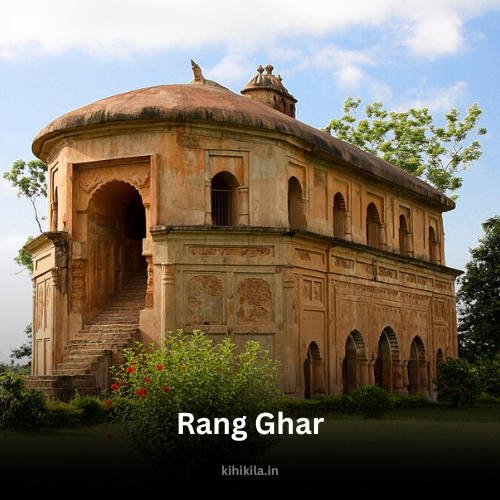Introduction
Rang Ghar, one of the most significant historical landmarks of Assam, stands as a testimony to the architectural brilliance of the Ahom dynasty. This two-storied structure, often referred to as the oldest amphitheater in Asia, was built in the 18th century under the reign of Swargadeo Pramatta Singha. The structure was used as a royal pavilion where Ahom kings and nobles witnessed traditional sports such as buffalo fights and wrestling during the grand celebrations of Rangali Bihu.
Unlike many ancient structures, Rang Ghar is not a fort or a temple but a unique entertainment house that holds immense historical and cultural value. Its distinctive architectural style, materials used in construction, and purpose make it an essential part of Assam’s rich heritage.
Historical Background
The construction of Rang Ghar dates back to 1746-1751, during the rule of Swargadeo Pramatta Singha. The Ahom dynasty, known for its architectural marvels, built this royal pavilion near the Talatal Ghar, another grand structure of the era. Rang Ghar was primarily designed for the royal family and aristocrats to enjoy traditional Assamese sports and grand festivities.
The presence of this structure highlights the Ahoms’ deep appreciation for entertainment, leisure, and organized sporting events. Unlike other historical buildings in India, which were built for governance or worship, Rang Ghar was specifically designed to cater to the royal family’s recreational needs, making it a one-of-a-kind structure.
Architectural Brilliance
Unique Design and Structure
Rang Ghar stands out with its oval-shaped design, measuring 27 meters in length, 11 meters in width, and 10 meters in height. The two-storied structure offers a clear view of the vast open field in front, where various sports and celebrations took place.
The roof of Rang Ghar features an intricately designed royal Ahom boat, a rare architectural element symbolizing Ahom naval power and artistic craftsmanship. The base of the monument consists of multiple arched entrances, allowing easy access to different sections of the pavilion.
Materials Used
One of the most fascinating aspects of Rang Ghar is the building materials. The Ahoms did not use modern cement or concrete; instead, they relied on an indigenous mixture of rice paste, eggs, and lime mortar to hold the bricks together. This traditional method has contributed to the remarkable durability of the structure, which has withstood the test of time for nearly three centuries.
Additionally, the structure features carved stone crocodiles at the top, adding to its grandeur and aesthetic appeal. Though some of these sculptural elements have worn out over time, their remnants provide a glimpse into the artistic mastery of Ahom craftsmen.
Significance in Assamese Culture
Rang Ghar is more than just an architectural marvel; it is a symbol of Assamese heritage. This structure represents the rich cultural past of Assam and its connection to traditional sports and entertainment. It was once a hub for large gatherings where royal members, nobles, and commoners united to celebrate festivals and witness grand events.
Association with the National Games
A testament to its cultural significance, Rang Ghar was chosen as the official logo of the 33rd National Games, held in Guwahati in 2007. This recognition further cemented its status as an enduring symbol of Assam’s sporting and cultural legacy.
Preservation and Current Status
Despite its historical importance, Rang Ghar has faced challenges due to natural wear and environmental damage. Efforts have been made by the Archaeological Survey of India (ASI) and the Assam government to preserve and restore this architectural gem.
Today, it remains a protected monument, attracting historians, researchers, and visitors eager to witness its grandeur. Conservation projects focus on maintaining the integrity of the structure while promoting awareness about its historical importance.
Conclusion
Rang Ghar is not just an ancient pavilion; it is a testament to the artistic, cultural, and architectural achievements of the Ahom dynasty. Its distinct purpose, unique design, and historical significance set it apart from other heritage sites in India. As one of the oldest surviving amphitheaters in Asia, Rang Ghar continues to stand as an enduring symbol of Assam’s glorious past.
Preserving this historical marvel is crucial to ensuring that future generations can appreciate and learn about Assam’s rich heritage. Whether you are a history enthusiast, an architecture lover, or someone interested in Assamese culture, Rang Ghar remains an awe-inspiring landmark that showcases the brilliance of an era gone by.












